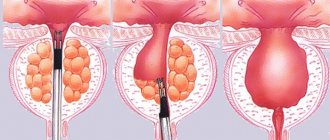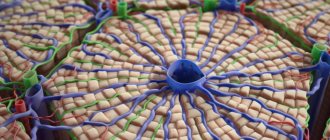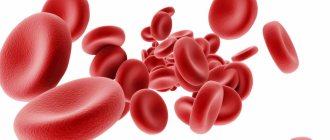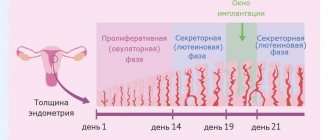Prolactin is increased in men
in stressful situations, with excessive physical exertion, with pain, after sexual intercourse, etc. - these are physiological reasons that do not require correction. Pathological causes include those in which a high concentration of the hormone is caused by disorders in the body.
These include:
- pituitary tumor and hypothalamic diseases;
- kidney and liver failure;
- prostatitis;
- hypothyroidism;
- inflammatory diseases of the central nervous system;
- systemic inflammatory diseases of connective tissue.
In addition, so-called idiopathic hyperprolactinemia, that is, pathology without an obvious cause, sometimes occurs.
Causes of elevated prolactin
Relationship between hormones
It should be noted that the level of prolactin in the male body is closely related to the production of estrogen: the more estrogen is synthesized, the higher the prolactin levels. These, in turn, affect the synthesis of testosterone, reducing its concentration. Hyperprolactinemia in men is a condition where prolactin is elevated.
Symptoms in men mostly concern the reproductive system. Decreased libido and potency are the most common complaints. Due to oligospermia (insufficient ejaculate volume), infertility develops. In addition, the motility and proper development of sperm are impaired. Gynecomastia also occurs - enlargement of the mammary glands of a benign nature, secondary sexual characteristics become less pronounced. As a result of the deviations that arise, a man often experiences psychological discomfort.
What is prolactin
Prolactin is a hormone of the anterior pituitary gland, necessary for lactation, stimulating the growth and development of the mammary glands, the production of colostrum and milk.
In men and non-pregnant women, it is formed in minimal quantities. In the blood, prolactin is found in four forms: microprolactin, large (macroprolactin), very large and glycosated (bound to glucose). The most active is microprolactin, its amount in the blood is 85%. The formation and release of prolactin is controlled by the substance dopamine, which is produced by the hypothalamus (a part of the diencephalon that controls the formation of hormones by the pituitary gland).
The production of prolactin increases under the influence of melatonin, estrogens, serotonin, thyrotropin-releasing hormone, against the background of stress, anxiety, severe pain, physical activity, and sexual intercourse. Dopamine and progesterone block prolactin synthesis. During pregnancy, it is high progesterone that temporarily inhibits the onset of lactation.
Diagnosis of the disease
The main examination for suspected hyperprolactinemia is to determine the level of prolactin in the blood. To get reliable results, you should not visit a sauna or bathhouse the day before the examination. You should also abstain from sexual intercourse. It is best to draw blood in the morning.
In addition, the patient is shown an X-ray of the skull. If there are signs of expansion of the sella turcica, computed tomography and magnetic resonance imaging are indicated. The scope of diagnostic measures is expanded depending on individual characteristics.
Prolactin is one of the hormones of the anterior pituitary gland. According to its chemical structure, it is a peptide hormone consisting of 199 ^ amino acid residues. Prolactin is secreted in lactotropic cells of the anterior pituitary gland, which constitute from 11 to 29% of the total cellular composition of the adenohypophysis. There is also extrapituitary secretion of prolactin, the significance of which, however, has not been definitively established [1].
Like human growth hormone, pituitary secretion of prolactin is under direct hypothalamic control and is not regulated by feedback. The hypothalamic-pituitary system has both an inhibitory and stimulating effect on prolactin secretion through neuroendocrine, autocrine and paracrine mechanisms [2]. The secretion of prolactin is constantly inhibited by the hypothalamic hormone dopamine. Dopamine is produced in neurons of the paraventricular and gray tuberous nuclei, as well as in neurons of the infundibulum nucleus and arcuate nucleus of the hypothalamus.
The inhibitory effect of dopamine is realized through stimulation of dopamine receptors localized on lactotropic cells. There are 2 types of dopamine receptors: Dj and D2. D1 receptors stimulate adenylate cyclase, and D2 receptors inhibit it. Dopamine and its agonists stimulate D2 receptors, which leads to inhibition of adenylate cyclase, a decrease in the amount of intracellular cAMP and a decrease in prolactin secretion. It is on this stimulation of D2 receptors that the effect of the therapeutic action of dopamine agonists (L-dopa, apomorphine, dopamine, bromocreptine, cabergoline) in the treatment of hyperprolactinemia is based. Estrogens, dopamine antagonists (phenothiazines, metoclopramide), serotonergic agonists (5-hydroxytryptophan), adrenergic inhibitors, sympatholytics (reserpine, α-methyldopa), opiates, acetylcholine, oxytocin, serotonin, have a prolactin-stimulating effect. melanostimulating hormone, TSHR (thyrotropin-releasing hormone), neurotensin, and hypoglycemia [3].
Prolactin, like other hormones, has a circadian rhythm of secretion. The maximum concentration of prolactin in human blood plasma is observed during sleep, the minimum level is in the morning, during awakening [4].
There are a number of physiological conditions accompanied by an increase in prolactin levels. Such conditions include, first of all, pregnancy and breastfeeding. In men, a physiological rise in prolactin levels can be observed during sleep, during intake of protein foods, physical activity, and in response to stress.
Pathological hyperprolactinemia is an increase in prolactin levels against the background of a particular disease or taking medications. Pathological hyperprolactinemia develops as a result of anatomical or functional disorders of the hypothalamic-pituitary system. In accordance with its origin, pathological hyperprolactinemia can be conditionally divided into hyperprolactinemia of tumor origin (prolactinoma) and non-tumor origin. In some cases, when it is not possible to establish the cause of pathological hyperprolactinemia, they talk about the idiopathic form of hyperprolactinemia, in which the function of pituitary cells increases, but their number does not change [2].
The level of prolactin can suggest the nature of hyperprolactinemia. An increase in prolactin levels by 1.5-3 times usually indicates non-tumor hyperprolactinemia. Hyperprolactinemia with an increase in prolactin levels from 2000 to 4500 mIU/l is observed, as a rule, with pituitary microadenomas; an increase in prolactin over 4500 mIU/l is typical for pituitary macroadenomas [5].
Prolactin has an effect on almost all organs and systems, so the clinical picture of hyperprolactinemia is extremely polymorphic.
| Figure 1. Regulation of prolactin secretion |
Table 1. Etiological factors of hyperprolactinemia
| Pathological hyperprolactinemia | Primary diseases of the hypothalamus and pituitary gland
Microadenoma (diameter up to 10 mm) Macroadenoma (diameter more than 10 mm) Rupture or transection of the pituitary stalk Empty sella syndrome Neurogenic stimulation Chest trauma or surgery Herpes zoster Excess TSHR (thyrotropin-releasing hormone) Primary hypothyroidism Idiopathic hyperprolactinemia Metabolic causes
Chronic renal failure and systemic hemodialysis Ectopic secretion of prolactin Neoplasms |
| Drug-induced hyperprolactinemia | Antihypertensive drugs (reserpine, methyldopa, verapamil) Dopamine receptor blockers
Estrogens Drugs (morphine, heroin, cocaine) Antiulcer drugs (cimetidine) |
| Kalinchenko S.Yu. A step forward in the treatment of hyperprolactinemia. Selected lectures. M., 2010.[2] | |
One of the main manifestations of hyperprolactinemia is impaired sexual and reproductive function, caused by a decrease in the secretion of gonadotropins against the background of hyperprolactinemia. In men, these disorders are expressed in decreased sexual desire and erectile dysfunction (ED) (50-85%), infertility due to oligozoospermia and ejaculation disorders (3-15%), gynecomastia (6-23%). With sexual dysfunction in men, hyperprolactinemia is detected in 0.4-11% of cases, and in some studies reaches 20%, therefore, studying the level of prolactin in the blood is an important step in diagnosing the causes of sexual dysfunction in men and ED in particular, as the most frequent manifestations of sexual dysfunction. In most cases, ED is only a symptom of the disease, so treatment should be comprehensive and aimed at eliminating the underlying problem. In the case of hyperprolactinemia, even a slight increase in prolactin levels can lead to erectile dysfunction. Therefore, in many cases, ED may be a marker of hyperprolactinemia [7]. At the same time, the diagnosis of hyperprolactinemia in men is complicated by the fact that characteristic complaints (decreased libido, ED and infertility) are not always associated with the presence of serious endocrinopathy. According to Buvat J., Lemaire A. (1997), hyperprolactinemia was detected in 3.18% of men with ED [8]. A high incidence of hyperprolactinemia (19.3%) among men with sexual disorders was reported by N. Grafeille (1997).
| Figure 2. Erectile function scores according to the IIEF scale in the main group of patients with ED (n = 1148) and the group of patients with hyperprolactinemia (n = 69) |
Other clinical manifestations of hyperprolactinemia are psychoemotional disorders, such as irritability, anxiety, depression, memory and mood deterioration, and sleep disturbances.
Neurological symptoms occur in patients with tumors of the hypothalamic-pituitary region and are caused directly by tumor growth. These symptoms include: headache, dizziness, visual disturbances (limited visual fields, double vision, decreased visual acuity).
Patients with prolactinemia may experience certain symptoms of endocrine disorders caused by loss of other pituitary functions (symptoms of pituitary insufficiency), such as symptoms of hypothyroidism (with decreased TSH secretion), symptoms of adrenal insufficiency (with decreased ACTH secretion), symptoms diabetes insipidus (with a decrease in the secretion of antidiuretic hormone), symptoms of hypogonadism (associated with a decrease in the secretion of LH, FSH). Some endocrine symptoms are caused directly by an increase in prolactin levels. These include galactorrhea, obesity, and insulin resistance.
TREATMENT OF HYPERPROLACTINEMIA
For all forms of hyperprolactinemia, incl. and tumor genesis, the main method of treatment is medication. Drug treatment is carried out using dopamine agonists, among which cabergoline (a third generation dopamine agonist) is currently the drug of choice. First generation dopamine agonists include lysergic acid derivatives (bromocriptine, methysergide), aminoergoline derivatives (lisuride, tergulide, mesulergine), clavine derivatives (pergolide, metergoline). Bromocriptine is the most common first generation dopamine analogue, which for a long time remained the “gold standard” in the treatment of hyperprolactinemia, effective in reducing prolactin levels and restoring reproductive and sexual function. In most patients, treatment with bromocriptine leads to a number of side effects, such as drowsiness, dizziness, headache, orthostatic decrease in blood pressure, nausea, vomiting, which is the reason for refusal of treatment in 12% of patients.
The imperfection of dopamine analogues of the first generation became the basis for the creation of new dopamine agonists of the second generation (quinagolide) and third generation (cabergoline), which today are the drugs of choice in the treatment of any form of hyperprolactinemia, more selective for D receptors and characterized by greater efficiency and better portability.
When treating erectile dysfunction in patients with hyperprolactinemia, normalization of prolactin levels comes to the fore. For this purpose, dopamine agonists are used, which are used in the first stage of treatment as monotherapy. In most cases, monotherapy with dopamine agonists restores erectile function. If monotherapy with dopamine agonists is ineffective, which is most often due to hypogonadism concomitant with hyperprolactinemia, therapy aimed at normalizing testosterone levels, as well as therapy with phosphodiesterase type 5 inhibitors (PDE-5), is prescribed. So according to Carani S. et al. (1996), treatment with bromocriptine restored erectile function before the level of testosterone in the blood increased (a decrease in libido may be a consequence of both dishormonal disorders and, possibly, the direct effect of prolactin on the brain) [9].
MATERIALS AND METHODS OF RESEARCH
We examined a large sample of patients with ED of various etiologies (n=1148). Hyperprolactinemia was detected among patients of the general group in 69 (9%) observations. In a retrospective study of 69 adult men with hyperprolactinemia, the dominant clinical symptoms were predominantly endocrine in nature. Decreased or absent libido was detected in 58 (84%), gynecomastia - 12 (17.4%), galactorrhea - 2 (2.9%), rare beard growth was noted in 4 (5.8%) patients. Focal cerebral symptoms were present in 23 (33.3%), headache in 15 (21.7%), limited visual fields in 4 (5.8%), diplopia in 2 (2.9%) patients. Testicular volume was normal (> or = 15 cm3) in all patients except five who had signs of late pubertal development. A decrease in visual acuity was noted in 32 (46.4%) patients. Increased fatigue among patients with hyperprolactinemia was detected in 29 (42%) patients, sleep disturbances in 31 (44.9%). Serum prolactin levels ranged from 360 to 8000 mU/L (mean 1200 mU/L, normal range
Data from sexological testing (IIEF scale) demonstrated the prevalence of more severe ED symptoms among patients with hyperprolactinemia compared to all patients in the general group (Figure 2).
When examined, 20 (28.9%) patients with hyperprolactinemia had low testosterone levels (
RESULTS AND ITS DISCUSSION
In our study, hyperprolactinemia was detected in 9% of cases, clinically manifested by a wide range of neurovegetative disorders against the background of pronounced manifestations of ED. These pathological symptoms were successfully relieved by a 1-2 month course of pathogenetic therapy with drugs that reduce the level of prolactin in the blood plasma.
Thus, testing the concentration of prolactin in the blood is an important step in diagnosing the causes of ED and should be performed in all patients with complaints of decreased erection quality.
Key words: erectile dysfunction, hyperprolactinemia, treatment, dopamine agonists, bromocriptine, quinagolide, cabergoline.
Keywords: erectile dysfunction, hyperprolactinemia, treatment, dopamine agonists, Bromocriptine, quinagolide, cabergoline.
LITERATURE
- Dedov I.I., Melnichenko G.A., Romantsova T.I. Hyperprolactinemia syndrome. M. 2004.
- Kalinchenko S.Yu. A step forward in the treatment of hyperprolactinemia. Selected lectures. M. 2010.
- Dzeranova L.K. Hyperprolactinemia syndrome in women and men: clinical picture, diagnosis, treatment: Dis. ... Dr. med. Sci. M. 2007.
- Dedov I.I., Dedov V.I. Biorhythms of hormones. M. 1992.
- Casanueva FF, Molitch ME, Schlechte JA, Abs R., Bonert V., Bronstein MD, Brue T., Cappabianca P., Colao A., Fahlbusch R., Fideleff H., Hadani M., Kelly P., Kleinberg D ., Laws E., Marek J., Scanlon M., Sobrinho LG, Wass JA, Giustina A. Guidelines of the Pituitary Society for the diagnosis and management of prolactinomas // Clin Endocrinol (Oxf). 2006. Vol. 65. No. 2. P. 265-73.
- Bhasin S., Enzlin P., Coviello A., Basson R. Sexual dysfunction in men and women with endocrine disorders // Lancet. 2007. Vol. 369. No. 9561. P. 597611.
- Johri AM, Heaton JP, Morales A. Severe erectile dysfunction is a marker for hyperprolactinemia // Int J Impot Res. 2001. Vol. 13. No. 3. P. 176-82.
- Buvat J., Lemaire A. Endocrine screening in 1,022 men with erectile dysfunction: clinical significance and cost-effective strategy / J Urol. 1997. Vol. 158. No. 5. P. 1764-1767.
- Carani C., Granata AR, Fustini MF, Marrama P. Prolactin and testosterone: their role in male sexual function // Int J Androl. 1996. Vol. 19. No. 1. P. 48-54.
| Attached file | Size |
| 730.96 kb |
‹ Endovideosurgery in pediatric urology, reconstructive plastic surgery in children Up Stages and prospects for the development of oncological urology in the Research Institute of Urology ›
Treatment of elevated prolactin in men
First of all, it is necessary to eliminate the cause that caused the increase in hormone levels. To reduce prolactin levels, medications are used as an initial remedy; the effect of their administration is usually noticeable after a short time. At the same time, impaired fertility functions are restored. If a tumor is present, treatment is aimed at reducing its size. If drug therapy is ineffective, surgical treatment is indicated. If, after a certain time after the operation, the prolactin level does not normalize, a combination treatment is recommended, including medications and radiation therapy.
How dopamine receptor agonists work
The role of prolactin in the female body
Prolactin in women prepares the ducts of the mammary glands for breastfeeding and supports lactation after childbirth.
Other effects of prolactin:
- strengthens the immune system;
- increases libido, promotes orgasm;
- reduces the formation of pituitary hormones that regulate the menstrual cycle - LH and FSH (inhibits menstruation);
- prevents ovulation and conception;
- retains water and sodium;
- enhances the absorption of calcium from food;
- accelerates hair and nail growth;
- relieves pain;
- regulates metabolic rate;
- influences mental reactions and behavior.
Blood test for prolactin
Prolactin is produced primarily in the adenohypophysis. This is the anterior lobe of the endocrine gland, which is located at the base of the brain. Prolactin synthesis also occurs in the cells of the placenta and decidua (the uterine mucosa modified due to pregnancy), immune organs, and structures of the central nervous system. The hypothalamus² is responsible for the regulation of these processes.
A certain level of PRL is detected not only in the blood, but also in the amniotic fluid surrounding the fetus, mucous secretions, and mother’s milk. A small amount of the substance is found in the cerebrospinal fluid - cerebrospinal fluid. A rarer source is hormone-producing tumors.
Prolactin in a blood test for hormones (Prolactin) is a significant indicator that can help with the diagnosis of female infertility³, tumors, and endocrine diseases. On the laboratory form it is indicated by the Russian name or abbreviation - PRL, PRL, LTH. The doctor may also prescribe determination of different fractions of the substance to clarify the suspected diagnosis.
Determining PRL in serum has its own difficulties, since there is a temporary change in concentration under physiological conditions (stress, physical activity, constitutional features) in the same person. Therefore, laboratories provide reference values in the form of digital ranges. The most common unit of measurement is mU/L (milli-international unit per liter of test material), but ng/ml (nanograms per milliliter) is also used. Converting ng/ml to honey/l is very easy - multiply the resulting value by 21.
Sources
- Bulatov A.A., Makarovskaya E.E., Marova E.I., Melnichenko G.A. Hyperprolactinemia with a predominance of high molecular weight immunoreactive prolactin: differences in the regulation of the level of high molecular weight and monomeric forms in the blood. Problems of Endocrinology. 1995;41(6):19-23
- Melnichenko G.A., Marova E.I., Dzeranova L.K., Vaks V.V. Hyperprolactinemia in women and men: A manual for doctors. M. 2008.
- Clinical recommendations of the Ministry of Health of the Russian Federation. Female infertility. Year of approval (revision frequency): 2021.
- Federal clinical recommendations of the Ministry of Health of the Russian Federation on hyperprolactinemia: clinical picture, diagnosis, differential diagnosis and treatment methods. 2021.
- Hyperprolactinemia syndrome in children and adolescents: causes, diagnosis, treatment. / V.V. Smirnov, F.I. Morozkina, M.D. Utev // Attending Physician. – 2014. – No. 12.
- Ph.D. Nebyltsova O.V., Klimova Zh.A., Nosenko G.A., Boyko I.V., Ph.D. Klishnya M.A., Chernyshova L.A., Knyazeva L.P., Malikova S.V., Danilova I.E., Abasheva S.N., Degtyarenko O.A., Prishchepa L.A. Laboratory handbook. 2011
- Obstetrics: national guide / ed. G. M. Savelyeva, G. T. Sukhikh, V. N. Serov, V. E. Radzinsky. — 2nd ed., revised. and additional - M.: GEOTAR-Media, 2021. - 1088 p. — (Series “National Guidelines”). — ISBN 978-5-9704-4551-8
- Crowley WR, Ramoz G, Torto R, Keefe KA, Wang JJ, Kalra SP. Neuroendocrine actions and regulation of hypothalamic neuropeptide Y during lactation. Peptides. 2007;28(2):447-452. doi:10.1016/j.peptides.2006.09.025
- Nad Yu.G. Hypoprolactinemia syndrome - a right to exist? // Eurasian Union of Scientists. 2015. No. 9-4 (18).
Preparing for analysis
Testing can be done at any phase of the menstrual cycle, but results will vary due to normal fluctuations in prolactin concentrations throughout the month. Usually the attending physician himself chooses the required period if he suggests some kind of diagnosis. When searching for the causes of infertility, the patient is sent to donate blood on days 2-5 of the cycle, if necessary, including other hormones in the list of tests³.
Men don't need to worry about calendar intricacies. It is enough just to follow the recommended rules before performing the analysis.
Patients (both men and women) should begin preparing for the study in advance - the informativeness of the data obtained depends on this. For 2-3 days before analysis, it is necessary to exclude the influence of such factors:
- sex;
- severe psycho-emotional overload;
- alcohol;
- exhausting physical activity;
- bath, sauna;
- solarium;
- binge eating;
- unbalanced consumption of sweet, fatty, protein foods;
- additional stimulation of the mammary glands and nipples - during self-examination, sexual stimulation, wearing tight bras;
- lack of sleep;
- calorie deficit diet;
- psychoactive substances.
Blood is drawn from a vein in the usual way in the morning from 8 to 11-12 hours. The patient comes on an empty stomach - the last meal can be taken the night before, and dinner should be light. A few hours before submitting the material, give up cigarettes and other types of smoking (vaping, hookah).
A test for prolactin will be uninformative if you donate blood in the acute period of inflammatory diseases - colds (ARVI), sinusitis, pneumonia. There is also no point in conducting analysis in the first weeks after surgery and trauma, especially in the chest area. Some pharmaceutical drugs (antidepressants, hormones) affect the level of prolactin in the blood serum. Usually 3-5 days before testing, their use is suspended. However, you cannot stop the prescribed therapy yourself - consult your doctor.








